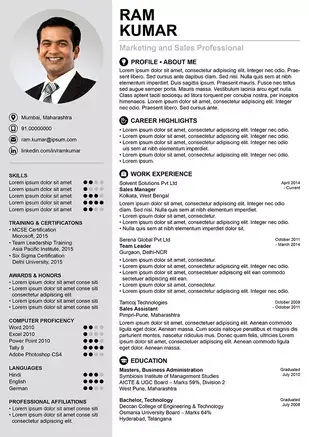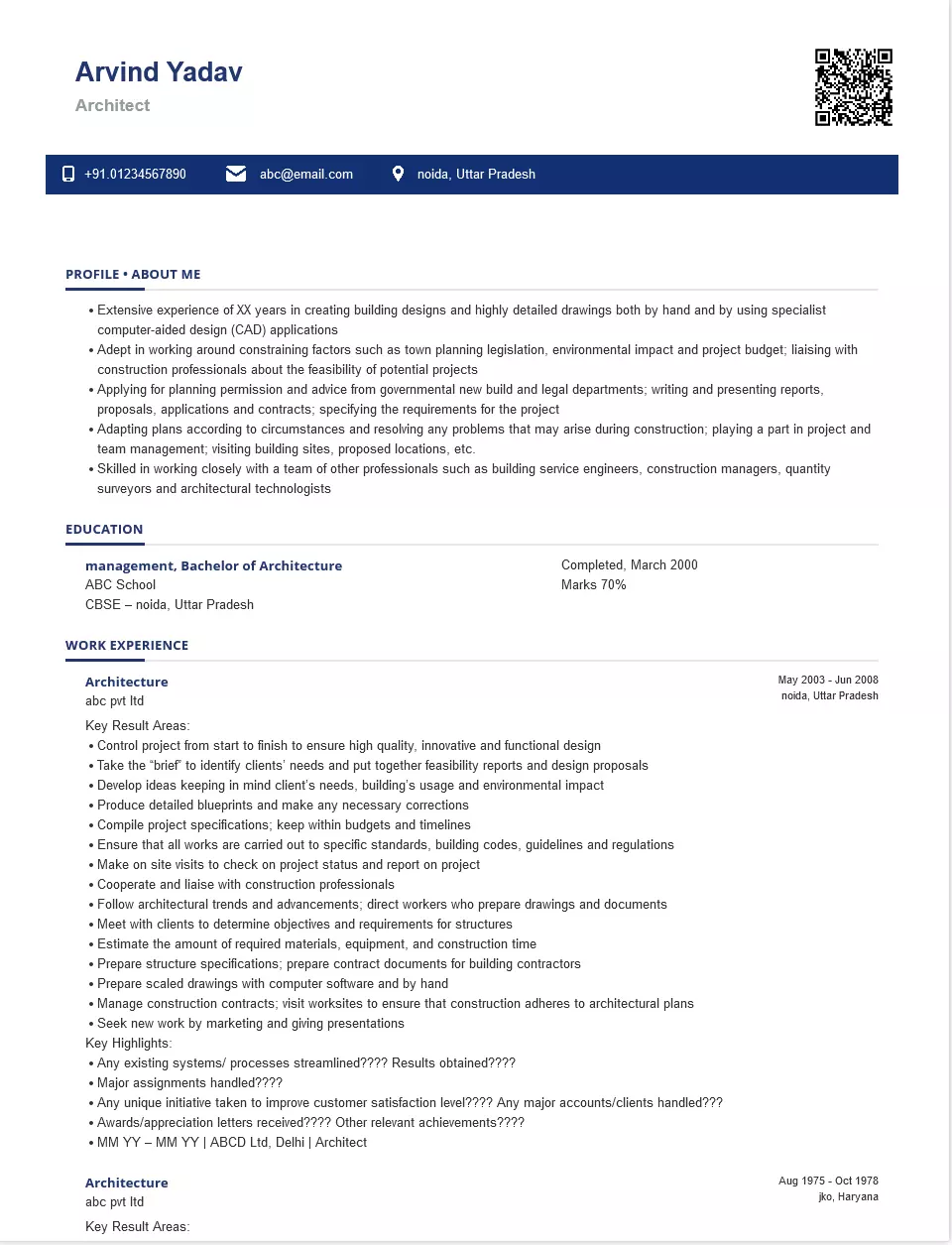- Certified Architect (Open CA) certification, Completed , January 2013
What's your job?
Architect Resume Samples and Templates for 2026
- Table of Contents
- Downloadable Sample
- Resume Tips from Experts
- Resume Text Version
- Share
Architect Resume Guide for India
A well-crafted Architect resume is essential for success in India’s dynamic construction and real estate sector. Whether you’re a fresher completing your B.Arch degree or an experienced professional seeking positions at top firms like Hafeez Contractor, CP Kukreja Architects, or leading real estate developers, this guide provides everything you need to create a standout resume that impresses Indian employers and passes ATS screening on portals like Naukri and LinkedIn.
This comprehensive guide includes:
- Resume format recommendations for Indian architecture sector
- Key skills Indian employers look for
- Complete resume example with Indian context
- Top architect employers in India
- Salary insights in INR by experience level
- Council of Architecture registration guidance
- ATS optimization tips for Indian job portals
Why Your Architect Resume Matters in India
India’s architecture and construction sector is experiencing significant growth with smart city projects, affordable housing initiatives, and commercial development. Organizations like DLF, Godrej Properties, L&T Realty, Shapoorji Pallonji, and leading architecture firms actively hire architects. A strong resume helps you:
- Stand out from thousands of architecture professionals on Naukri and LinkedIn
- Pass ATS screening used by real estate companies and architecture firms
- Showcase skills that Indian hiring managers value, including AutoCAD, Revit, sustainable design, and project management
- Demonstrate your design portfolio and project delivery capabilities
Indian architecture recruiters typically spend 6-10 seconds reviewing each resume initially. Your Architect resume must immediately communicate your COA registration status, design expertise, and ability to deliver projects on time and within budget. With India’s infrastructure boom, a well-optimized resume is essential.
Architect Resume Format for India
Indian employers prefer clean, professional resume formats. Here’s what works best:
Recommended Format
- Length: 1-2 pages (freshers: 1 page, experienced: 2 pages max)
- Layout: Reverse chronological (most recent first)
- Font: Arial, Calibri, or Times New Roman (11-12pt)
- Sections: Contact, Summary, Skills, Experience, Projects, Education, Registration, Certifications
- Portfolio Link: Essential for architects
Resume vs Biodata
In India, use a professional resume format for private sector roles. “Biodata” format may be used for government positions (CPWD, PWD recruitment).
Personal Details for Indian Architect Resumes
Indian resumes typically include:
- Full name with credentials (B.Arch, M.Arch)
- Phone number with country code (+91)
- Professional email address
- LinkedIn profile URL
- Portfolio website/Behance link
- City, State (full address not required)
- COA Registration Number (Important!)
What to Avoid
- Decorative fonts or graphics (causes ATS issues)
- Personal information like religion, caste, or father’s name
- Salary expectations (discuss during interview)
- References (provide when requested)
Key Skills for Architects in India
Indian employers look for comprehensive architecture expertise covering design, technical skills, and project management.
Design Software (Essential)
- AutoCAD: 2D drafting, construction drawings
- Revit: BIM modeling, coordination
- SketchUp: Conceptual design, 3D modeling
- 3ds Max/V-Ray: Rendering, visualization
- Rhino/Grasshopper: Parametric design
- Lumion: Real-time rendering
Design Skills
- Conceptual Design: Space planning, form development
- Sustainable Design: Green buildings, GRIHA, LEED
- Interior Design: Space planning, material selection
- Landscape Design: Site planning, outdoor spaces
- Urban Design: Master planning, urban planning
Technical Skills
- Working Drawings: Construction documentation
- Building Codes: NBC, local building bylaws
- Structural Coordination: RCC, steel structures
- MEP Coordination: Services integration
- Quantity Estimation: BOQ preparation
Project Management
- Project Coordination: Contractor liaison, site supervision
- Client Management: Presentations, approvals
- Documentation: Drawing management, specifications
- Cost Estimation: Budget preparation, value engineering
Soft Skills for Indian Architecture Firms
- Communication: Client presentations, team coordination
- Creativity: Design thinking, problem-solving
- Attention to Detail: Drawing accuracy, specifications
- Time Management: Deadline adherence
- Teamwork: Collaborative design process
How to Present Skills
Create a dedicated skills section. Group by category (Design Software, Design Skills, Technical). Include portfolio link prominently.
Architect Resume Example for India
Here’s a complete resume example tailored for Indian employers:
Arjun Menon, B.Arch, M.Arch (Urban Design)
Bangalore, Karnataka | +91-98XXX-XXXXX | arjun.menon.architect@email.com | linkedin.com/in/arjunmenon-architect
Portfolio: www.arjunmenonarchitect.com | Behance: behance.net/arjunmenon
Registered Architect | Council of Architecture, India | Reg. No.: CA/XXXX/XXXXX
Professional Summary
Creative and detail-oriented Architect with 8+ years of experience in residential, commercial, and mixed-use project design. Expertise in sustainable design, BIM implementation, and project management with proven track record of delivering ₹200 Cr+ worth of projects on time and within budget. Proficient in Revit, AutoCAD, and 3ds Max with GRIHA certified projects. Strong background in both high-end residential and large-scale commercial developments. COA registered architect with M.Arch in Urban Design from CEPT. Seeking to contribute design expertise to an innovative architecture practice.
Skills
Design Software: AutoCAD (Expert), Revit (Expert), SketchUp, 3ds Max, V-Ray, Lumion, Rhino, Adobe Creative Suite Design: Conceptual Design, Sustainable Design, Interior Design, Urban Design, Master Planning Technical: Working Drawings, Building Codes (NBC), Structural Coordination, MEP Integration, BOQ Preparation Management: Project Coordination, Client Management, Site Supervision, Contractor Liaison, Team Leadership Certifications: GRIHA Certified Professional, LEED Green Associate
Professional Experience
Senior Architect | RSP Design Consultants | Bangalore | April 2020 – Present
- Lead design team of 6 architects for commercial and mixed-use projects worth ₹150 Cr+
- Designed 5 Lakh sq.ft. IT park achieving GRIHA 4-star rating for sustainable design
- Implemented BIM workflows using Revit reducing coordination issues by 40%
- Manage client relationships with major developers including Brigade Group and Prestige
- Coordinate with structural and MEP consultants for integrated design solutions
- Conduct design reviews and mentor junior architects on technical standards
- Achieved 95% client satisfaction through innovative design solutions and timely delivery
Architect | Hafeez Contractor | Mumbai | June 2017 – March 2020
- Designed high-rise residential towers for prominent Mumbai developers
- Prepared construction drawings for 10+ residential projects totaling 25 Lakh sq.ft.
- Coordinated with PMC and contractors for on-site execution
- Developed sustainable design strategies achieving 30% energy savings
- Participated in design competitions winning 2 major project awards
- Managed drawing submissions and approvals with BMC authorities
Junior Architect | CP Kukreja Architects | Delhi | July 2015 – May 2017
- Assisted senior architects in conceptual design and development
- Prepared AutoCAD drawings and 3D visualizations for client presentations
- Conducted site visits and prepared site analysis reports
- Supported tender documentation and BOQ preparation
- Contributed to institutional and healthcare project designs
Key Projects
Brigade Tech Park | Bangalore | 2022 – 2023
- 5 Lakh sq.ft. IT park with sustainable design features
- Role: Lead Architect
- Technologies: Revit, 3ds Max, sustainable systems
- Achievement: GRIHA 4-star rating, ₹75 Cr project value
Prestige Residential Tower | Bangalore | 2021 – 2022
- 45-storey luxury residential tower
- Role: Project Architect
- Technologies: Revit, AutoCAD, coordination with structure
- Achievement: Premium design features, on-time delivery
TATA Housing Project | Mumbai | 2018 – 2020
- Affordable housing project with 500+ units
- Role: Design Architect
- Technologies: AutoCAD, cost-effective design
- Achievement: 20% cost optimization, PMAY compliance
Education
Master of Architecture (M.Arch) in Urban Design | CEPT University, Ahmedabad | 2015
- CGPA: 8.2/10
- Thesis: Sustainable Urban Regeneration in Indian Metropolitan Cities
- Studio Excellence Award
Bachelor of Architecture (B.Arch) | SPA Delhi | 2013
- CGPA: 7.8/10
- Final Year Thesis: Mixed-Use Development for Transit-Oriented Design
- Design Competition Winner (2nd Place)
Registration & Licenses
- Registered Architect | Council of Architecture, India | Reg. No.: CA/XXXX/XXXXX | 2015
- Licensed to Practice | COA (Active)
Certifications
- GRIHA Certified Professional | TERI | 2019
- LEED Green Associate | USGBC | 2020
- Revit Architecture Professional | Autodesk Certified | 2018
- Advanced BIM Training | NIASA | 2021
Professional Memberships
- Member, Indian Institute of Architects (IIA)
- Member, Council of Architecture (COA)
- Associate Member, IGBC
Awards & Recognition
- Design Excellence Award - RSP Design | 2022
- A+D Awards Shortlist - Residential Category | 2019
- IIA Young Architect Award Nominee | 2018
Languages
English (Fluent) | Hindi (Fluent) | Kannada (Native) | Malayalam (Native)
Declaration
I hereby declare that the information provided above is true to the best of my knowledge.
Arjun Menon Bangalore, December 2024
Top Architect Employers in India
India’s architecture sector offers diverse opportunities. Here are the top employers:
Leading Architecture Firms
- Hafeez Contractor: High-rise residential, commercial
- CP Kukreja Architects: Institutional, commercial
- Morphogenesis: Sustainable design
- Sanjay Puri Architects: Award-winning designs
- RSP Design Consultants: International projects
- Edifice Consultants: Commercial, healthcare
- IMK Architects: Master planning
- Arcop Associates: Multi-sector
Real Estate Developers (In-House Design)
- DLF: Commercial, residential
- Godrej Properties: Residential, commercial
- Prestige Group: Mixed-use, commercial
- Brigade Group: IT parks, residential
- Lodha Group: Luxury residential
- Shapoorji Pallonji: Construction, development
- L&T Realty: Commercial, residential
Government Organizations
- CPWD: Central government projects
- State PWD: State projects
- Smart City SPVs: Urban development
- Housing Boards: Affordable housing
- Metro Rail Corporations: Transit projects
MNC Design Firms
- Gensler India: Global projects
- HOK India: Healthcare, commercial
- Perkins+Will: Sustainable design
- Aedas: Large-scale projects
How to Apply
- Apply through Naukri.com and LinkedIn
- Architecture firm websites directly
- IIA job portal
- ArchitectureLive job listings
- Campus placements (for freshers)
Architect Salary in India
Architecture offers stable careers with growth potential. Salaries vary based on experience, firm type, and specialization.
Salary by Experience Level
| Experience | Small Firms (INR) | Large Firms/Developers (INR) |
|---|---|---|
| Fresher B.Arch (0-2 years) | ₹2.5 - ₹5 LPA | ₹4 - ₹8 LPA |
| Junior Architect (2-5 years) | ₹5 - ₹10 LPA | ₹8 - ₹15 LPA |
| Senior Architect (5-10 years) | ₹10 - ₹20 LPA | ₹15 - ₹30 LPA |
| Principal/Partner (10+ years) | ₹20 - ₹40 LPA | ₹30 - ₹60 LPA |
Note: MNC firms and top developers pay premium packages.
Salary by City
| City | Salary Range (Mid-Level) |
|---|---|
| Mumbai | ₹10 - ₹22 LPA |
| Delhi NCR | ₹9 - ₹20 LPA |
| Bangalore | ₹9 - ₹20 LPA |
| Pune | ₹7 - ₹16 LPA |
| Chennai | ₹7 - ₹15 LPA |
| Hyderabad | ₹7 - ₹15 LPA |
Factors Affecting Salary
- Firm Type: MNC/large developers pay more
- Specialization: Sustainable design, BIM expertise valued
- Education: M.Arch from premier institutes adds premium
- Portfolio: Award-winning projects boost value
- COA Registration: Mandatory for practice
- Software Skills: Revit/BIM expertise highly valued
Salary data based on Glassdoor India, AmbitionBox, and industry surveys.
COA Registration & Certifications for Architects
Council of Architecture registration is mandatory for practicing architecture in India.
Mandatory Registration
- Council of Architecture (COA): Mandatory registration to practice
- B.Arch from COA recognized college: Basic qualification
- Renewal: Periodic renewal required
Core Qualifications
- B.Arch: 5-year degree from COA recognized institution
- M.Arch: Specialization (Urban Design, Landscape, Conservation)
- Ph.D. in Architecture: Research and academics
Valuable Certifications
- GRIHA Certified Professional: Indian green building
- LEED Green Associate/AP: International sustainability
- Autodesk Certified Professional: Revit, AutoCAD
- BIM Certification: Building Information Modeling
Professional Development
- IIA Continuing Education: Professional development
- IGBC Courses: Green building training
- Workshop Training: Various design skills
How to List Registration
Always include COA registration number prominently. COA registration is mandatory to practice architecture in India.
ATS Tips for Your Architect Resume
Most companies use Applicant Tracking Systems (ATS) to screen resumes. Optimize yours:
For Naukri.com
- Use keywords from job descriptions (Architect, AutoCAD, Revit, BIM)
- Keep formatting simple (no tables, columns, or graphics)
- Use standard section headings (Experience, Education, Skills)
- Upload in .docx or .pdf format
- Update profile every 15 days
- Include portfolio link
For LinkedIn Applications
- Match resume to LinkedIn profile
- Use standard job titles (Architect, Senior Architect, Principal Architect)
- Include COA registration number
- Showcase portfolio on LinkedIn
- Get endorsements from colleagues
General ATS Tips
- DO: Standard fonts, clear headings, bullet points
- DO: Include metrics (₹200 Cr projects, 5 Lakh sq.ft., GRIHA rating)
- DO: Mention software proficiency clearly
- DON’T: Use headers/footers, text boxes, images
- DON’T: Use creative section titles
Keyword Strategy for Architect Roles
Common keywords from job postings:
- Architect, Senior Architect, Principal Architect
- AutoCAD, Revit, SketchUp, 3ds Max, BIM
- Residential, Commercial, Mixed-Use, Institutional
- Sustainable Design, GRIHA, LEED, Green Building
- COA Registered, B.Arch, M.Arch
- Working Drawings, Construction Documents
Final Tips for Your Architect Resume
✅ Include COA registration prominently—mandatory in India
✅ Quantify achievements (₹200 Cr projects, 5 Lakh sq.ft., GRIHA rating)
✅ Show software expertise—Revit/BIM skills highly valued
✅ Include portfolio link—essential for architects
✅ Demonstrate sustainability knowledge—GRIHA/LEED projects
✅ Show project diversity—residential, commercial, institutional
✅ Proofread carefully—attention to detail critical
Quick Checklist
- Contact with +91 phone, LinkedIn, and portfolio link
- COA registration number prominently displayed
- Professional summary highlighting project scale and expertise
- Skills organized by category (Software, Design, Technical)
- Experience showing project values and sq.ft.
- Key projects with achievements
- Education with B.Arch/M.Arch and CGPA
- Certifications (GRIHA, LEED, Autodesk)
- Professional memberships (IIA, COA)
- ATS-friendly formatting
- Declaration statement
Ready to create your professional Architect resume? Use our resume builder to get started with expert-designed templates optimized for Indian job portals.
For more guidance on resume structure, check out our resume format guide with tips specifically for the Indian architecture job market.
Architect Text-Only Resume Templates and Samples
Arvind Yadav
Phone: 01234567890
Email: abc@email.com
Address: Sec-44, Noida, Noida
About Me
Architect / Project Architect / Senior Architect
- Extensive experience of XX years in creating building designs and highly detailed drawings both by hand and by using specialist computer-aided design (CAD) applications
- Adept in working around constraining factors such as town planning legislation, environmental impact, and project budget; liaising with construction professionals about the feasibility of potential projects
- Applying for planning permission and advice from governmental new build and legal departments; writing and presenting reports, proposals, applications, and contracts; specifying the requirements for the project
- Adapting plans according to circumstances and resolving any problems that may arise during construction; playing a part in the project and team management; visiting building sites, proposed locations, etc.
- Skilled in working closely with a team of other professionals such as building service engineers, construction managers, quantity surveyors, and architectural technologists
Education
Architecture, Master of Architecture, Completed, March 2000
College of Engineering
UPTU – Marks 70
Noida, UP
Certifications
Work Experience
Period: May 2003 - Current
Senior Architect
Abc Pvt Ltd
- Control project from start to finish to ensure high-quality, innovative, and functional design
- Take the “brief” to identify clients’ needs and put together feasibility reports and design proposals
- Develop ideas keeping in mind the client’s needs, building’s usage, and environmental impact
- Produce detailed blueprints and make any necessary corrections
- Compile project specifications; keep within budgets and timelines
- Ensure that all works are carried out to specific standards, building codes, guidelines, and regulations
- Make on-site visits to check on project status and report on project
- Cooperate and liaise with construction professionals
- Follow architectural trends and advancements; direct workers who prepare drawings and documents
- Meet with clients to determine objectives and requirements for structures
- Estimate the number of required materials, equipment, and construction time
- Prepare structure specifications; prepare contract documents for building contractors
- Prepare scaled drawings with computer software and by hand
- Manage construction contracts; visit worksites to ensure that construction adheres to architectural plans
- Seek new work by marketing and giving presentations
Period: August 1975 - October 1978
Architecture
Ambux pvt ltd
- Consulted with the client to determine functional and spatial requirements of the structure
- Prepared information regarding design, structure specifications, materials, color, equipment, estimated costs, and construction time
- Conducted periodic on-site observation of work during construction to monitor compliance with plans
- Administered construction contracts
- Prepared operating and maintenance manuals, studies, and reports
Skills
- CAD
- Revit
- Estimating
- Budgeting
- Project Management
- Renovation
- Communication
- Collaboration
- Interpersonal Skills
- Problem-Solving
Languages
Softwares
Operating System
Personal Interests
- Tennis
- Cycling
- Sketching
- Photography
- Design
 India's
premier resume service
India's
premier resume service





